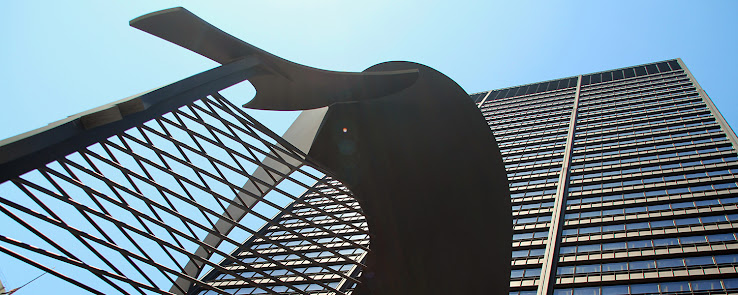 |
| Haymarket Memorial |
Haymarket Memorial - by Mary Brogger
Unveiled: 2004
Bronze / H 15 ft. x W 9 ft. x L 16 ft.
Location: Desplaines St. between Lake and Randolph Sts..
The site of Haymarket Tragedy was designated a Chicago Landmark on March 25, 1992
 |
| Haymarket Memorial |
 |
| Haymarket Memorial |
There are plaques detailing the historic significance of this sculpture ...
It reads ...
"On the evening of May 4, 1886, a tragedy of international significance unfolded in Chicago's Haymarket produce district. An outdoor meeting had been hastily organized by anarchist activists to protest the violent death of workers during a labor lockout the previous day in another area of the city. Spectators gathered in the street as speakers addressed political, social and labor issues from atop a freight wagon from the adjacent factory. When approximately 175 policemen approached with an order to disperse the meeting, a dynamite bomb was thrown into their ranks.
The identity and affiliation of the person who threw the bomb have never been determined; this anonymous act had many victims. From the blast and panic that followed, seven policemen and at least four civilian bystanders lost their lives, but the victims of the incident were not limited to those who died as a direct result of the bombing. In the aftermath, those who organized and spoke at the meeting – and others who held unpopular political viewpoints – were arrested, unfairly tried and, in some cases, sentenced to death even though none could be tied to the bombing itself.
 |
| Haymarket Memorial |
Meeting organizers George Engel and Adolf Fisher along with speakers August Spies and Albert Parsons were put to death by hanging. Activist Louis Lingg died violently in jail prior to his scheduled execution. Meeting speaker Samuel Fielden, and activists Oscar Neebe and Michael Schwab were sentenced to prison, but later pardoned in 1893 bu Illinois Governor John Peter Altgeld, citing the injustices of their trial.
Over the years, the site of the Haymarket bombing has become a powerful symbol for a diverse cross-section of people, ideals and movements. Its significance touches on the issues of free speech, the right of public assembly, organized labor, the fight for the eight hour work day, law enforcement, justice, anarchy and the right of every human being to pursue an equitable and prosperous life. For all, it is a poignant lesson in the rewards and consequences inherent in such human pursuits.."
 |
| Haymarket Memorail |
Drawing on the symbolism of the wagon used as the speakers’ platform during the meeting, Mary Brogger’s sculpture marks the precise location where the wagon stood and the events occurred.

The plaque reads:
"The site of Haymarket Tragedy was designated a Chicago Landmark on March 25, 1992."
There are some signs of vandalism/graffiti on the site ... Mayor Richard M. Daley's name has been vandalized and the Seal of the City of Chicago has been painted over by hand with a "circle-A," a symbol of anarchism.
Haymarket Square Memorial - by John Gelert [1889]
Captain with upraised arm, as a memorial to slain policemen..
On the base are the words.."In the name of the people of Illinois I comman peace.."
Location: Chicago Police HQ Building, 35th Street and Michigan Ave..





No comments:
Post a Comment